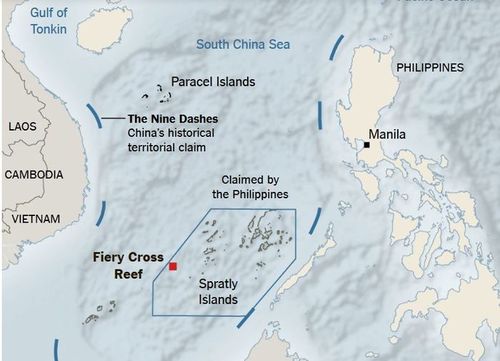
Should We Fight for the Spratlys?
10/29/2015
Trailed by two Chinese warships, the guided-missile destroyer USS Lassen sailed inside the 12-nautical-mile limit of Subi Reef, a man-made island China claims as her national territory.
Beijing protested. Says China: Subi Reef and the Spratly Island chain, in a South China Sea that carries half of the world’s seaborne trade, are as much ours as the Aleutians are yours.
Beijing’s claim to the Spratlys is being contested by Vietnam, Malaysia, Brunei, the Philippines and Taiwan. While Hanoi and Manila have occupied islets and built structures to back their claims, the Chinese have been more aggressive.
They have occupied rocks and reefs with troops, dredged and expanded them into artificial islands, fortified them, put up radars and are building air strips and harbors.
What the Chinese are about is easy to understand.
Having feasted and grown fat on trade surpluses with the United States, the Chinese are translating their economic strength into military power and a new strategic assertiveness.
They want to dominate East Asia and all the seas around it.
We have been told our warships are unwelcome in the Yellow Sea and the Taiwan Strait. Beijing also claims the Senkakus that Japan occupies, which are covered by our mutual security treaty.
And not only is the South China Sea one of the world’s crucial waterways, the fish within can feed nations and the floor below contains vast deposits of oil and gas.
Who owns the islands in the South China Sea owns the sea.
Moreover, our world has changed since Eisenhower threatened to use nuclear weapons to defend Taiwan and the offshore islands of Quemoy and Matsu — and since Bill Clinton sent two U.S. carrier battle groups through the Taiwan Strait.
Now we send a lone destroyer inside the 12-mile limit of a reef that, until recently, was under water at high tide.
What China is doing is easily understandable. She is emulating the United States as we emerged to become an imperial power.
After we drove Spain out of Cuba in 1898, we annexed Puerto Rico and the Hawaiian Islands, where America settlers had deposed the queen, took Wake and Guam, and annexed the Philippines. The subjugation of Filipino resistance required a three-year war and thousands of dead Marines.
And the reaction of President McKinley when he heard our Asian squadron had seized the islands:
"When we received the cable from Admiral Dewey telling of the taking of the Philippines I looked up their location on the globe. I could not have told where those darned islands were within 2,000 miles."
In 1944, General MacArthur, whose father had crushed the Filipino resistance, retook the islands from the Japanese who had occupied them after Pearl Harbor.
At the end of the Cold War, however, Manila ordered the United States to get out of Clark Air Force Base and Subic Bay naval base. We did as told. Now our Filipino friends want us back to confront China for them, as do the Vietnamese Communists in Hanoi.
Before we get ourselves into the middle of their dispute, before we find ourselves in an air war or naval clash with China, we ought to ask ourselves a few questions.
First, why is this our quarrel? We have no claim to any of the Spratly or Paracel Islands in the South China Sea. Yet, each of the claimants — Beijing, Taipei, Manila, Hanoi — seems to have maps going back decades and even centuries to support those claims.
Besides freedom of the seas, what is our vital interest here?
If these islands are Chinese territory, Beijing has the same right to build air and naval bases on them as we do in the Aleutians, Hawaii, Wake and Guam. What do we hope to accomplish by sailing U.S. warships into what China claims to be her territorial waters?
While the ships of the U.S. Seventh Fleet are superior to those of the Chinese navy, China has more submarines, destroyers, frigates and missile boats, plus a vast inventory of ground-based missiles that can target warships at great distances.
In an increasingly nationalist China, Xi Jinping could not survive a climbdown of China’s claims, or dismantlement of what Beijing has built in the South China Sea. President Xi no more appears to be a man to back down than does President Putin.
Continued U.S. overflights or naval intrusion into the territorial waters of Chinese-claimed islands are certain to result in a violent clash, as happened near Hainan Island in 2001.
Where would we go from there?
China today is in trouble. She is feared and distrusted by her neighbors; her economy has lost its dynamism; and the Communist Party is riven by purges and rampant corruption.
If we believe this will be the Second American Century, that time is on our side, that Chinese communism is a dead faith, we ought to avoid a clash and show our opposition to Beijing’s excesses, if need be, by imposing tariffs on all goods made in China.
China’s oligarchs will understand that message.
Patrick J. Buchanan
